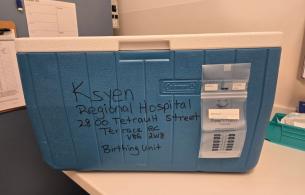Bright packaging, celebrity endorsers, and viral marketing – these are some of the reasons energy drinks create quite a buzz! According to the 2023 BC Adolescent Health Survey, the number of teens using energy drinks has doubled in the past five years. Not only are teens often the targets of marketing, but they are one of the groups most impacted by the negative health effects of caffeinated energy drinks.
In my role as a dietitian, I’ve spoken with many parents and teachers who are concerned about the growing popularity, ease of access, and health impacts of these drinks.
But advice like “don’t drink it because it’s bad for you” can backfire. There are many reasons teens may choose these products, including social norms, advertising, and the perception that they boost energy or physical performance.
So, what are parents and schools to do? While I can’t offer any “silver bullet” solutions, here are a few thoughts:
Approach talking to teens about energy drinks with curiosity
Aim to understand where teens are coming from; this can open the door to meaningful dialogue. Consider open-ended questions like:
- What do you know about energy drinks and how they affect your health?
- Why do you think teens go for energy drinks?
- What do you like about them?
Based on the responses, you might share facts or brainstorm alternative solutions. For example, if a teen’s using energy drinks because they feel tired, explore changes they could make to their daily routine that could help them feel more energized.
Encourage being critical about how energy drinks are marketed
Energy drinks are a multi-billion-dollar industry that uses aggressive marketing strategies. Support critical thinking with questions like:
- What tactics do companies use to make you want to buy their energy drinks? Do they use celebrities, cool packaging, special deals, or try to play with your emotions?
- Do you think what they’re saying is true?
- Who’s making money from these drinks? Who might be hurt by them?
Most teens hate feeling as though they’re being taken advantage of.
Supplemented foods are prepackaged foods with added ingredients like vitamins, minerals, amino acids or other ingredients (for example, caffeine). Check out this infographic to learn how to understand supplemented food labels.
Teach label reading to support informed choices
Reading food labels helps us know how much caffeine is in a product. Health Canada recommends that teens (14-18 years old) consume no more than 180 mg of caffeine per day (equivalent to about one cup of coffee). Have teens think about all the food and drinks they consume each day – they might be getting more caffeine than they realize!
Did you know? One energy drink can contain up to 200 mg of caffeine, which is more than the daily limit for teens. Teaching young people how to read food labels can help them make informed choices.
As of January 2026, Health Canada will be requiring new labels on all supplemented foods, including caffeinated energy drinks. To learn more, check out the Health Canada poster in this article, or watch this video.
Have water and other healthy drinks readily available
To help teens choose water more often, make it readily available at home and at school. Encourage packing a leakproof water bottle for school, activities, and trips. Milk and fortified soy beverages are also hydrating and nutritious options. Try to role-model these healthy drink habits for teens when you can.
Don’t sell or promote energy drinks in your school, or during special events
Consider a school-district-wide policy that does not allow energy drink sales, promotional posters, or sponsorship. Some schools may choose to ban energy drinks entirely. If a student brings these products to class, let them know about the school policy without judging or shaming their choices.
How have you approached talking about energy drinks with teens? Let us know what has worked well (and not so well)!
For more information
- Caffeinated energy drinks (Health Link BC)
- Learn about Canada’s supplemented foods labelling (Health Canada)














Comments